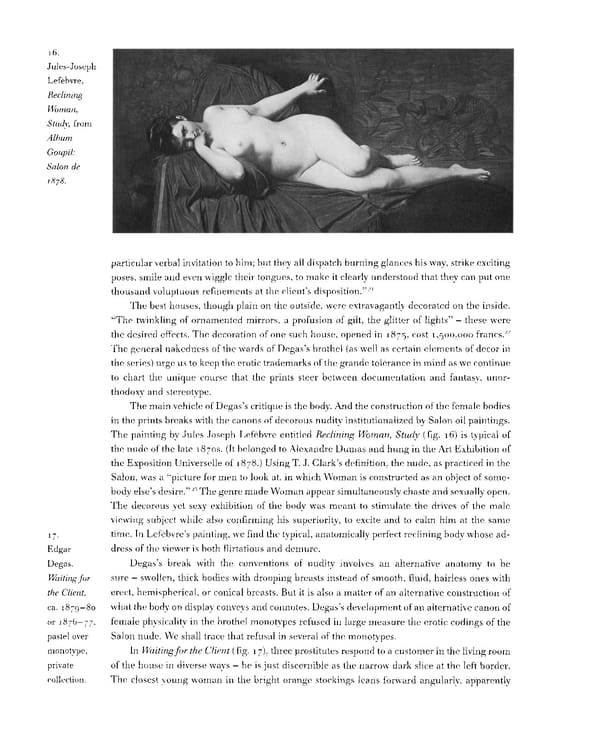i6. Jules-Joseph Lefebvre, Reclining Woman, from Study, Album Goupil: Salon de 1878. particular verbal invitation to him; but they all dispatch burning glances his way, strike exciting poses, smile and even wiggle their tongues, to make it clearly understood that they can put one 21 thousand voluptuous refinements at the client's disposition." The best houses, though plain on the outside, were extravagantly decorated on the inside. "The twinkling of ornamented mirrors, a profusion of gilt, the glitter of lights" — these were 22 the desired effects. The decoration of one such house, opened in 1875, cost 1,500,000 francs. The general nakedness of the wards of Degas's brothel (as well as certain elements of decor in the series) urge us to keep the erotic trademarks of the grande tolerance in mind as we continue to chart the unique course that the prints steer between documentation and fantasy, unor- thodoxy and stereotype. The main vehicle of Degas's critique is the body. And the construction of the female bodies in the prints breaks with the canons of decorous nudity institutionalized by Salon oil paintings. The painting by Jules Joseph Lefebvre entitled Reclining Woman, Study (fig. 16) is typical of the nude of the late 18705. (It belonged to Alexandre Dumas and hung in the Art Exhibition of the Exposition Universelle of 1878.) Using T. J. Clark's definition, the nude, as practiced in the Salon, was a "picture for men to look at, in which Woman is constructed as an object of some- 25 body else's desire." The genre made Woman appear simultaneously chaste and sexually open. The decorous yet sexy exhibition of the body was meant to stimulate the drives of the male viewing subject while also confirming his superiority, to excite and to calm him at the same 17- time. In Lefebvre's painting, we find the typical, anatomically perfect reclining body whose ad- Edgar dress of the viewer is both flirtatious and demure. Degas, Degas's break with the conventions of nudity involves an alternative anatomy to be Waiting for sure — swollen, thick bodies with drooping breasts instead of smooth, fluid, hairless ones with the Client, erect, hemispherical, or conical breasts. But it is also a matter of an alternative construction of ca. 1879 — 80 what the body on display conveys and connotes. Degas's development of an alternative canon of or 1876—77, female physicality in the brothel monotypes refused in large measure the erotic codings of the pastel over Salon nude. We shall trace that refusal in several of the monotypes. monotype, In Waiting for the Client (fig. i 7), three prostitutes respond to a customer in the living room private of the house in diverse ways - he is just discernible as the narrow dark slice at the left border. collection. The closest young woman in the bright orange stockings leans forward angularly, apparently
 Prostitution & Impressionists Page 56 Page 58
Prostitution & Impressionists Page 56 Page 58